转载自: https://www.cnblogs.com/ningskyer/articles/3615312.html
0.分类
创建型模式
1、FACTORY 2、BUILDER 3、FACTORY METHOD 4、PROTOTYPE 5、SINGLETON
结构型模式
6、ADAPTER 7、BRIDGE 8、COMPOSITE 9、DECORATOR 10、FACADE 11、FLYWEIGHT 12、PROXY
行为模式
13、CHAIN OF RESPONSIBLEITY 14、COMMAND 15、INTERPRETER 16、ITERATOR 17、MEDIATOR
18、MEMENTO 19、OBSERVER 20、STATE 21、STRATEGY 22、TEMPLATE METHOD 23、VISITOR
1.图示版
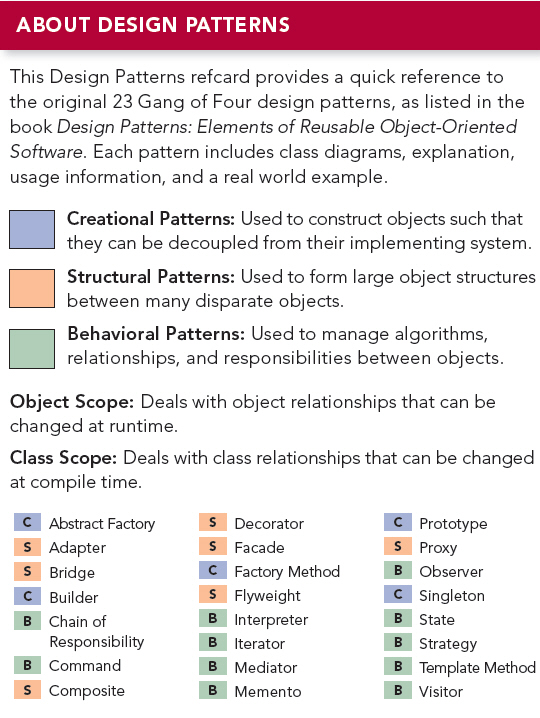
责任链模式
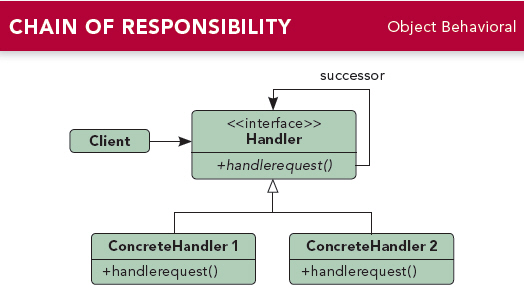
Purpose
Gives more than one object an opportunity to handle a request by linking receiving objects together.
Use When
- Multiple objects may handle a request and the handler doesn't have to be a specific object.
- A set of objects should be able to handle a request with the handler determined at runtime.
- A request not being handled is an acceptable potential outcome.
Example
Exception handling in some languages implements this pattern. When an exception is thrown in a method the runtime checks to see if the method has a mechanism to handle the exception or if it should be passed up the call stack. When passed up the call stack the process repeats until code to handle the exception is encountered or until there are no more parent objects to hand the request to.
命令模式
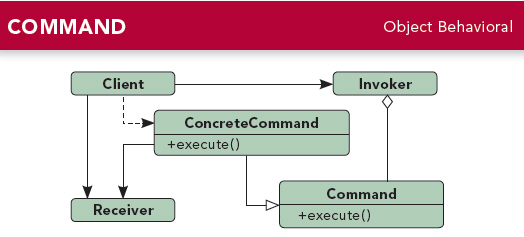
解释器模式
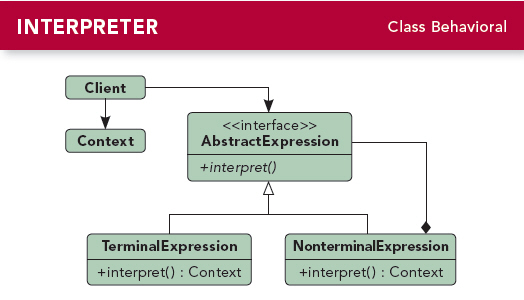
Purpose
Defines a representation for a grammar as well as a mechanism to understand and act upon the grammar.
Use When
- There is grammar to interpret that can be represented as large syntax trees.
- The grammar is simple.
- Efficiency is not important.
- Decoupling grammar from underlying expressions is desired.
Example
Text based adventures, wildly popular in the 1980's, provide a good example of this. Many had simple commands, such as "step down" that allowed traversal of the game. These commands could be nested such that it altered their meaning. For example, "go in" would result in a different outcome than "go up". By creating a hierarchy of commands based upon the command and the qualifier (non-terminal and terminal expressions) the application could easily map many command variations to a relating tree of actions.
迭代器模式
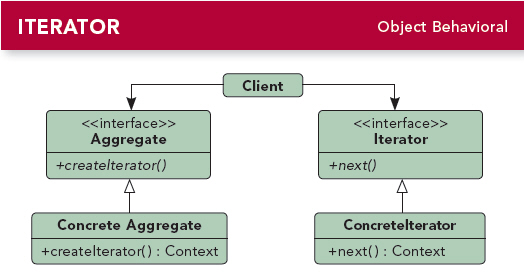
Purpose
Allows for access to the elements of an aggregate object without allowing access to its underlying representation.
Use When
- Access to elements is needed without access to the entire representation.
- Multiple or concurrent traversals of the elements are needed.
- A uniform interface for traversal is needed.
- Subtle differences exist between the implementation details of various iterators.
Example
The Java implementation of the iterator pattern allows users to traverse various types of data sets without worrying about the underlying implementation of the collection. Since clients simply interact with the iterator interface, collections are left to define the appropriate iterator for themselves. Some will allow full access to the underlying data set while others may restrict certain functionalities, such as removing items.
中介者模式
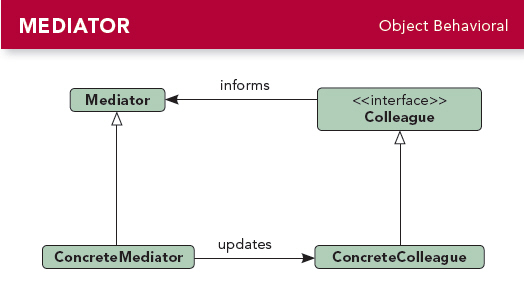
Purpose
Allows loose coupling by encapsulating the way disparate sets of objects interact and communicate with each other. Allows for the actions of each object set to vary independently of one another.
Use When
- Communication between sets of objects is well defined and complex.
- Too many relationships exist and common point of control or communication is needed.
Example
Mailing list software keeps track of who is signed up to the mailing list and provides a single point of access through which any one person can communicate with the entire list. Without a mediator implementation a person wanting to send a message to the group would have to constantly keep track of who was signed up and who was not. By implementing the mediator pattern the system is able to receive messages from any point then determine which recipients to forward the message on to, without the sender of the message having to be concerned with the actual recipient list.
备忘录模式
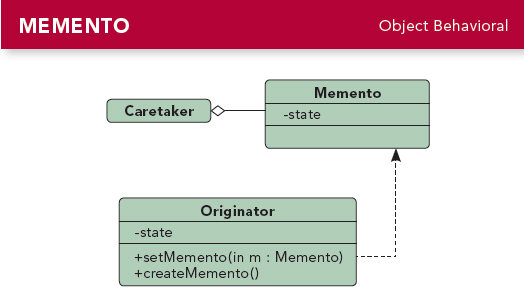
Purpose
Allows for capturing and externalizing an object's internal state so that it can be restored later, all without violating encapsulation.
Use When
- The internal state of an object must be saved and restored at a later time.
- Internal state cannot be exposed by interfaces without exposing implementation.
- Encapsulation boundaries must be preserved.
Example
Undo functionality can nicely be implemented using the memento pattern. By serializing and deserializing the state of an object before the change occurs we can preserve a snapshot of it that can later be restored should the user choose to undo the operation.
观察者模式
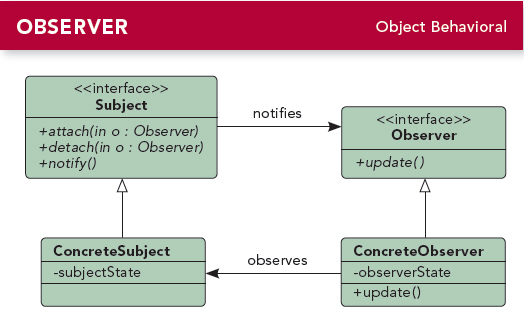
Purpose
Lets one or more objects be notified of state changes in other objects within the system.
Use When
- State changes in one or more objects should trigger behavior in other objects
- Broadcasting capabilities are required.
- An understanding exists that objects will be blind to the expense of notification.
Example
This pattern can be found in almost every GUI environment. When buttons, text, and other fields are placed in applications the application typically registers as a listener for those controls. When a user triggers an event, such as clicking a button, the control iterates through its registered observers and sends a notification to each.
状态模式
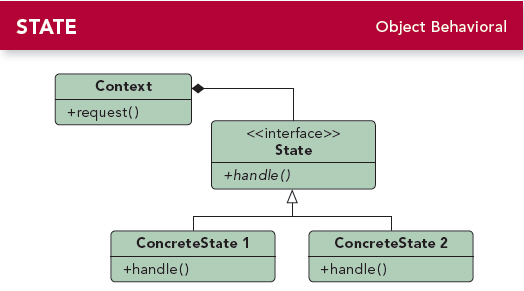
Purpose
Ties object circumstances to its behavior, allowing the object to behave in different ways based upon its internal state.
Use When
- The behavior of an object should be influenced by its state.
- Complex conditions tie object behavior to its state.
- Transitions between states need to be explicit.
Example
An email object can have various states, all of which will change how the object handles different functions. If the state is "not sent" then the call to send() is going to send the message while a call to recallMessage() will either throw an error or do nothing. However, if the state is "sent" then the call to send() would either throw an error or do nothing while the call to recallMessage() would attempt to send a recall notification to recipients. To avoid conditional statements in most or all methods there would be multiple state objects that handle the implementation with respect to their particular state. The calls within the Email object would then be delegated down to the appropriate state object for handling.
策略模式
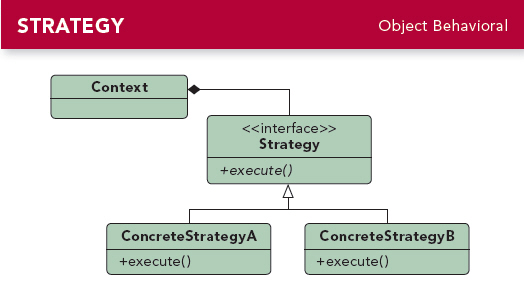
Purpose
Defines a set of encapsulated algorithms that can be swapped to carry out a specific behavior.
Use When
- The only difference between many related classes is their behavior.
- Multiple versions or variations of an algorithm are required.
- Algorithms access or utilize data that calling code shouldn't be exposed to.
- The behavior of a class should be defined at runtime.
- Conditional statements are complex and hard to maintain.
Example
When importing data into a new system different validation algorithms may be run based on the data set. By configuring the import to utilize strategies the conditional logic to determine what validation set to run can be removed and the import can be decoupled from the actual validation code. This will allow us to dynamically call one or more strategies during the import.
模板方法模式
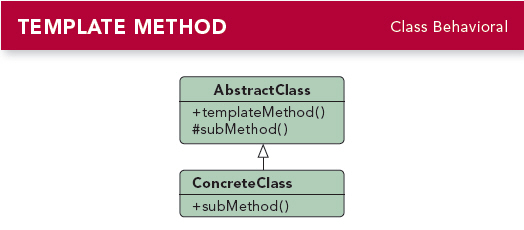
Purpose
Identifies the framework of an algorithm, allowing implementing classes to define the actual behavior.
Use When
- A single abstract implementation of an algorithm is needed.
- Common behavior among subclasses should be localized to a common class.
- Parent classes should be able to uniformly invoke behavior in their subclasses.
- Most or all subclasses need to implement the behavior.
Example
A parent class, InstantMessage, will likely have all the methods required to handle sending a message. However, the actual serialization of the data to send may vary depending on the implementation. A video message and a plain text message will require different algorithms in order to serialize the data correctly. Subclasses of InstantMessage can provide their own implementation of the serialization method, allowing the parent class to work with them without understanding their implementation details.
访问者模式
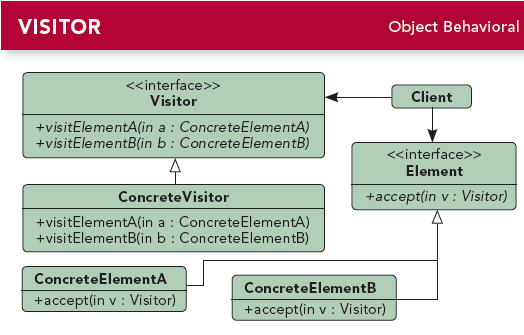
Purpose
Allows for one or more operations to be applied to a set of objects at runtime, decoupling the operations from the object structure.
Use When
- An object structure must have many unrelated operations performed upon it.
- The object structure can't change but operations performed on it can.
- Operations must be performed on the concrete classes of an object structure.
- Exposing internal state or operations of the object structure is acceptable.
- Operations should be able to operate on multiple object structures that implement the same interface sets.
Example
Calculating taxes in different regions on sets of invoices would require many different variations of calculation logic. Implementing a visitor allows the logic to be decoupled from the invoices and line items. This allows the hierarchy of items to be visited by calculation code that can then apply the proper rates for the region. Changing regions is as simple as substituting a different visitor.
适配器模式
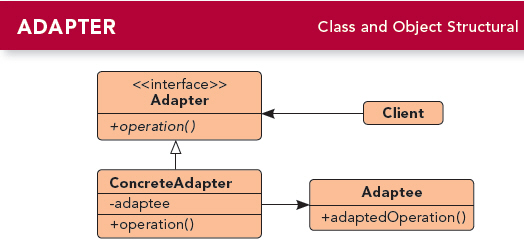
Purpose
Permits classes with disparate interfaces to work together by creating a common object by which they may communicate and interact.
Use When
- A class to be used doesn't meet interface requirements.
- Complex conditions tie object behavior to its state.
- Transitions between states need to be explicit.
Example
A billing application needs to interface with an HR application in order to exchange employee data, however each has its own interface and implementation for the Employee object. In addition, the SSN is stored in different formats by each system. By creating an adapter we can create a common interface between the two applications that allows them to communicate using their native objects and is able to transform the SSN format in the process.
桥接模式
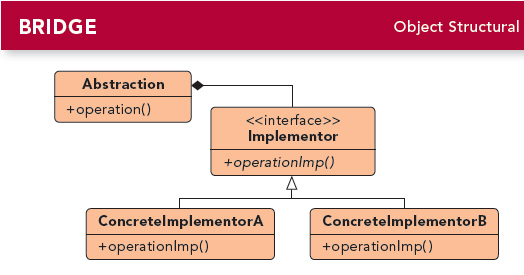
Purpose
Defines an abstract object structure independently of the implementation object structure in order to limit coupling.
Use When
- Abstractions and implementations should not be bound at compile time.
- Abstractions and implementations should be independently extensible.
- Changes in the implementation of an abstraction should have no impact on clients.
- Implementation details should be hidden from the client.
Example
The Java Virtual Machine (JVM) has its own native set of functions that abstract the use of windowing, system logging, and byte code execution but the actual implementation of these functions is delegated to the operating system the JVM is running on. When an application instructs the JVM to render a window it delegates the rendering call to the concrete implementation of the JVM that knows how to communicate with the operating system in order to render the window.
组合模式
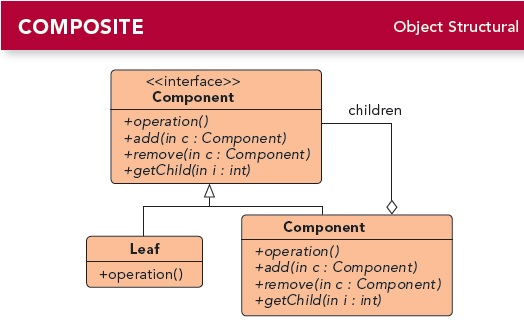
Purpose
Facilitates the creation of object hierarchies where each object can be treated independently or as a set of nested objects through the same interface.
Use When
- Hierarchical representations of objects are needed.
- Objects and compositions of objects should be treated uniformly.
Example
Sometimes the information displayed in a shopping cart is the product of a single item while other times it is an aggregation of multiple items. By implementing items as composites we can treat the aggregates and the items in the same way, allowing us to simply iterate over the tree and invoke functionality on each item. By calling the getCost() method on any given node we would get the cost of that item plus the cost of all child items, allowing items to be uniformly treated whether they were single items or groups of items.
装饰者模式
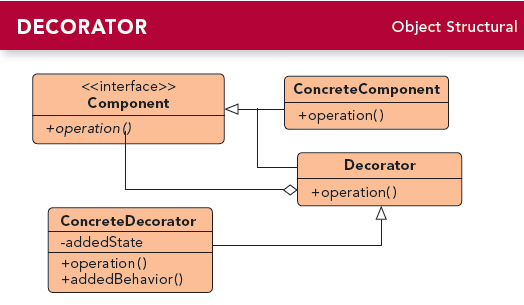
Purpose
Allows for the dynamic wrapping of objects in order to modify their existing responsibilities and behaviors.
Use When
- Object responsibilities and behaviors should be dynamically modifiable.
- Concrete implementations should be decoupled from responsibilities and behaviors.
- Subclassing to achieve modification is impractical or impossible.
- Specific functionality should not reside high in the object hierarchy.
- A lot of little objects surrounding a concrete implementation is acceptable.
Example
Many businesses set up their mail systems to take advantage of decorators. When messages are sent from someone in the company to an external address the mail server decorates the original message with copyright and confidentiality information. As long as the message remains internal the information is not attached. This decoration allows the message itself to remain unchanged until a runtime decision is made to wrap the message with additional information.
门面模式
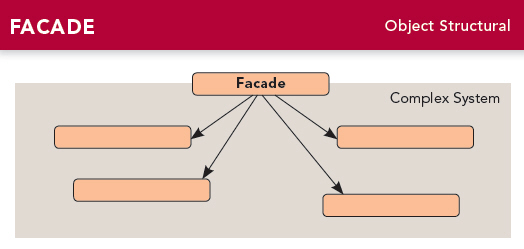
Purpose
Supplies a single interface to a set of interfaces within a system.
Use When
- A simple interface is needed to provide access to a complex system.
- There are many dependencies between system implementations and clients.
- Systems and subsystems should be layered.
Example
By exposing a set of functionalities through a web service the client code needs to only worry about the simple interface being exposed to them and not the complex relationships that may or may not exist behind the web service layer. A single web service call to update a system with new data may actually involve communication with a number of databases and systems, however this detail is hidden due to the implementation of the façade pattern.
享元模式
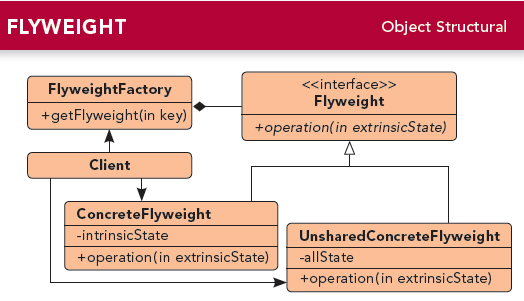
Purpose
Facilitates the reuse of many fine grained objects, making the utilization of large numbers of objects more efficient.
Use When
- Many like objects are used and storage cost is high.
- The majority of each object's state can be made extrinsic.
- A few shared objects can replace many unshared ones.
- The identity of each object does not matter.
Example
Systems that allow users to define their own application flows and layouts often have a need to keep track of large numbers of fields, pages, and other items that are almost identical to each other. By making these items into flyweights all instances of each object can share the intrinsic state while keeping the extrinsic state separate. The intrinsic state would store the shared properties, such as how a textbox looks, how much data it can hold, and what events it exposes. The extrinsic state would store the unshared properties, such as where the item belongs, how to react to a user click, and how to handle events.
代理模式
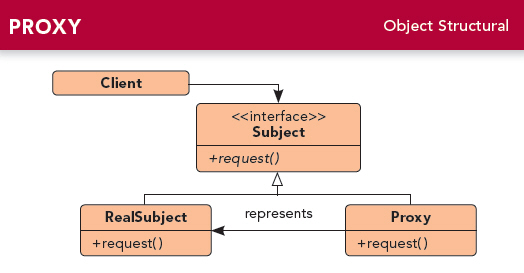
Purpose
Allows for object level access control by acting as a pass through entity or a placeholder object.
Use When
- The object being represented is external to the system.
- Objects need to be created on demand.
- Access control for the original object is required.
- Added functionality is required when an object is accessed.
Example
Ledger applications often provide a way for users to reconcile their bank statements with their ledger data on demand, automating much of the process. The actual operation of communicating with a third party is a relatively expensive operation that should be limited. By using a proxy to represent the communications object we can limit the number of times or the intervals the communication is invoked. In addition, we can wrap the complex instantiation of the communication object inside the proxy class, decoupling calling code from the implementation details.
抽象工厂模式
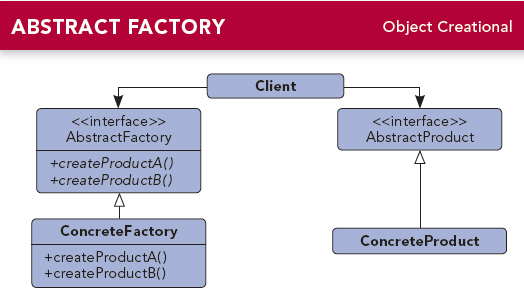
Purpose
Provide an interface that delegates creation calls to one or more concrete classes in order to deliver specific objects.
Use When
- The creation of objects should be independent of the system utilizing them.
- Systems should be capable of using multiple families of objects.
- Families of objects must be used together.
- Libraries must be published without exposing implementation details.
- Concrete classes should be decoupled from clients.
Example
Email editors will allow for editing in multiple formats including plain text, rich text, andHTML Depending on the format being used, different objects will need to be created. If the message is plain text then there could be a body object that represented just plain text and an attachment object that simply encrypted the attachment into Base64. If the message is HTML then the body object would represent HTML encoded text and the attachment object would allow for inline representation and a standard attachment. By utilizing an abstract factory for creation we can then ensure that the appropriate object sets are created based upon the style of email that is being sent.
建造模式
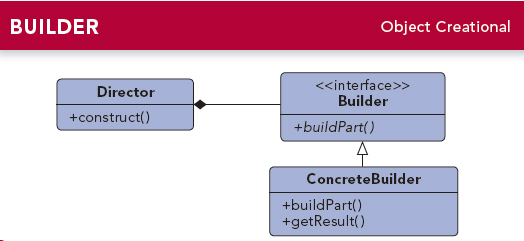
Purpose
Allows for the dynamic creation of objects based upon easily interchangeable algorithms.
Use When
- Object creation algorithms should be decoupled from the system.
- Multiple representations of creation algorithms are required.
- The addition of new creation functionality without changing the core code is necessary.
- Runtime control over the creation process is required.
Example
A file transfer application could possibly use many different protocols to send files and the actual transfer object that will be created will be directly dependent on the chosen protocol. Using a builder we can determine the right builder to use to instantiate the right object. If the setting is FTP then the FTP builder would be used when creating the object.
工厂方法模式
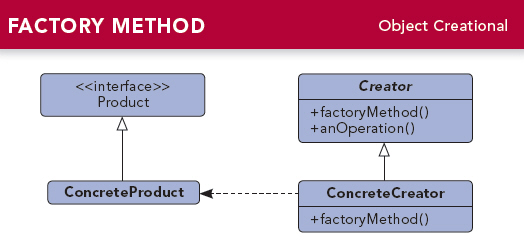
Purpose
Exposes a method for creating objects, allowing subclasses to control the actual creation process.
Use When
- A class will not know what classes it will be required to create.
- Subclasses may specify what objects should be created.
- Parent classes wish to defer creation to their subclasses.
Example
Many applications have some form of user and group structure for security. When the application needs to create a user it will typically delegate the creation of the user to multiple user implementations. The parent user object will handle most operations for each user but the subclasses will define the factory method that handles the distinctions in the creation of each type of user. A system may have AdminUser and StandardUser objects each of which extend the User object. The AdminUser object may perform some extra tasks to ensure access while the StandardUser may do the same to limit access.
原型模式
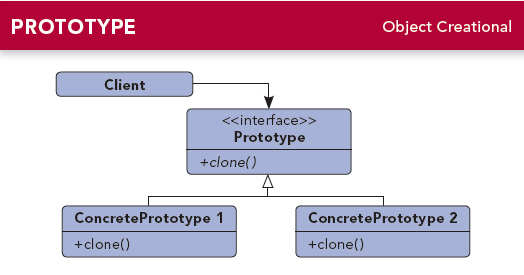
Purpose
Create objects based upon a template of an existing objects through cloning.
Use When
- Composition, creation, and representation of objects should be decoupled from a system.
- Classes to be created are specified at runtime.
- A limited number of state combinations exist in an object.
- Objects or object structures are required that are identical or closely resemble other existing objects or object structures.
- The initial creation of each object is an expensive operation.
Example
Rates processing engines often require the lookup of many different configuration values, making the initialization of the engine a relatively expensive process. When multiple instances of the engine is needed, say for importing data in a multi-threaded manner, the expense of initializing many engines is high. By utilizing the prototype pattern we can ensure that only a single copy of the engine has to be initialized then simply clone the engine to create a duplicate of the already initialized object. The added benefit of this is that the clones can be streamlined to only include relevant data for their situation.
单例模式
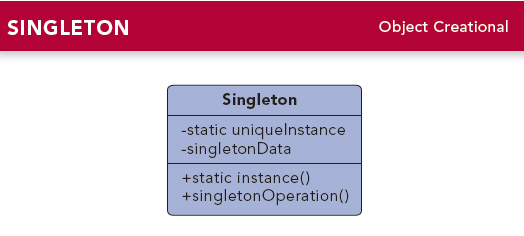
Purpose
Ensures that only one instance of a class is allowed within a system.
Use When
- Exactly one instance of a class is required.
- Controlled access to a single object is necessary.
Example
Most languages provide some sort of system or environment object that allows the language to interact with the native operating system. Since the application is physically running on only one operating system there is only ever a need for a single instance of this system object. The singleton pattern would be implemented by the language runtime to ensure that only a single copy of the system object is created and to ensure only appropriate processes are allowed access to it.
2.大话版
创建型模式
1、FACTORY—追MM少不了请吃饭了,麦当劳的鸡翅和肯德基的鸡翅都是MM爱吃的东西,虽然口味有所不同,但不管你带MM去麦当劳或肯德基,只管向服务员说“来四个鸡翅”就行了。麦当劳和肯德基就是生产鸡翅的Factory
工厂模式:客户类和工厂类分开。消费者任何时候需要某种产品,只需向工厂请求即可。消费者无须修改就可以接纳新产品。缺点是当产品修改时,工厂类也要做相应的修改。如:如何创建及如何向客户端提供。
2、BUILDER—MM最爱听的就是“我爱你”这句话了,见到不同地方的MM,要能够用她们的方言跟她说这句话哦,我有一个多种语言翻译机,上面每种语言都有一个按键,见到MM我只要按对应的键,它就能够用相应的语言说出“我爱你”这句话了,国外的MM也可以轻松搞掂,这就是我的“我爱你”builder。(这一定比美军在伊拉克用的翻译机好卖)
建造模式:将产品的内部表象和产品的生成过程分割开来,从而使一个建造过程生成具有不同的内部表象的产品对象。建造模式使得产品内部表象可以独立的变化,客户不必知道产品内部组成的细节。建造模式可以强制实行一种分步骤进行的建造过程。
3、FACTORY METHOD—请MM去麦当劳吃汉堡,不同的MM有不同的口味,要每个都记住是一件烦人的事情,我一般采用Factory Method模式,带着MM到服务员那儿,说“要一个汉堡”,具体要什么样的汉堡呢,让MM直接跟服务员说就行了。
工厂方法模式:核心工厂类不再负责所有产品的创建,而是将具体创建的工作交给子类去做,成为一个抽象工厂角色,仅负责给出具体工厂类必须实现的接口,而不接触哪一个产品类应当被实例化这种细节。
4、PROTOTYPE—跟MM用QQ聊天,一定要说些深情的话语了,我搜集了好多肉麻的情话,需要时只要copy出来放到QQ里面就行了,这就是我的情话prototype了。(100块钱一份,你要不要)
原型模式:通过给出一个原型对象来指明所要创建的对象的类型,然后用复制这个原型对象的方法创建出更多同类型的对象。原始模型模式允许动态的增加或减少产品类,产品类不需要非得有任何事先确定的等级结构,原始模型模式适用于任何的等级结构。缺点是每一个类都必须配备一个克隆方法。
5、SINGLETON—俺有6个漂亮的老婆,她们的老公都是我,我就是我们家里的老公Sigleton,她们只要说道“老公”,都是指的同一个人,那就是我(刚才做了个梦啦,哪有这么好的事)
单例模式:单例模式确保某一个类只有一个实例,而且自行实例化并向整个系统提供这个实例单例模式。单例模式只应在有真正的“单一实例”的需求时才可使用。
结构型模式
6、ADAPTER—在朋友聚会上碰到了一个美女Sarah,从香港来的,可我不会说粤语,她不会说普通话,只好求助于我的朋友kent了,他作为我和Sarah之间的Adapter,让我和Sarah可以相互交谈了(也不知道他会不会耍我)
适配器模式:把一个类的接口变换成客户端所期待的另一种接口,从而使原本因接口原因不匹配而无法一起工作的两个类能够一起工作。适配类可以根据参数返还一个合适的实例给客户端。
7、BRIDGE—早上碰到MM,要说早上好,晚上碰到MM,要说晚上好;碰到MM穿了件新衣服,要说你的衣服好漂亮哦,碰到MM新做的发型,要说你的头发好漂亮哦。不要问我“早上碰到MM新做了个发型怎么说”这种问题,自己用BRIDGE组合一下不就行了
桥梁模式:将抽象化与实现化脱耦,使得二者可以独立的变化,也就是说将他们之间的强关联变成弱关联,也就是指在一个软件系统的抽象化和实现化之间使用组合/聚合关系而不是继承关系,从而使两者可以独立的变化。
8、COMPOSITE—Mary今天过生日。“我过生日,你要送我一件礼物。”“嗯,好吧,去商店,你自己挑。”“这件T恤挺漂亮,买,这条裙子好看,买,这个包也不错,买。”“喂,买了三件了呀,我只答应送一件礼物的哦。”“什么呀,T恤加裙子加包包,正好配成一套呀,小姐,麻烦你包起来。”“……”,MM都会用Composite模式了,你会了没有?
合成模式:合成模式将对象组织到树结构中,可以用来描述整体与部分的关系。合成模式就是一个处理对象的树结构的模式。合成模式把部分与整体的关系用树结构表示出来。合成模式使得客户端把一个个单独的成分对象和由他们复合而成的合成对象同等看待。
9、DECORATOR—Mary过完轮到Sarly过生日,还是不要叫她自己挑了,不然这个月伙食费肯定玩完,拿出我去年在华山顶上照的照片,在背面写上“最好的的礼物,就是爱你的Fita”,再到街上礼品店买了个像框(卖礼品的MM也很漂亮哦),再找隔壁搞美术设计的Mike设计了一个漂亮的盒子装起来……,我们都是Decorator,最终都在修饰我这个人呀,怎么样,看懂了吗?
装饰模式:装饰模式以对客户端透明的方式扩展对象的功能,是继承关系的一个替代方案,提供比继承更多的灵活性。动态给一个对象增加功能,这些功能可以再动态的撤消。增加由一些基本功能的排列组合而产生的非常大量的功能。
10、FACADE—我有一个专业的Nikon相机,我就喜欢自己手动调光圈、快门,这样照出来的照片才专业,但MM可不懂这些,教了半天也不会。幸好相机有Facade设计模式,把相机调整到自动档,只要对准目标按快门就行了,一切由相机自动调整,这样MM也可以用这个相机给我拍张照片了。
门面模式:外部与一个子系统的通信必须通过一个统一的门面对象进行。门面模式提供一个高层次的接口,使得子系统更易于使用。每一个子系统只有一个门面类,而且此门面类只有一个实例,也就是说它是一个单例模式。但整个系统可以有多个门面类。
11、FLYWEIGHT—每天跟MM发短信,手指都累死了,最近买了个新手机,可以把一些常用的句子存在手机里,要用的时候,直接拿出来,在前面加上MM的名字就可以发送了,再不用一个字一个字敲了。共享的句子就是Flyweight,MM的名字就是提取出来的外部特征,根据上下文情况使用。
享元模式:FLYWEIGHT在拳击比赛中指最轻量级。享元模式以共享的方式高效的支持大量的细粒度对象。享元模式能做到共享的关键是区分内蕴状态和外蕴状态。内蕴状态存储在享元内部,不会随环境的改变而有所不同。外蕴状态是随环境的改变而改变的。外蕴状态不能影响内蕴状态,它们是相互独立的。将可以共享的状态和不可以共享的状态从常规类中区分开来,将不可以共享的状态从类里剔除出去。客户端不可以直接创建被共享的对象,而应当使用一个工厂对象负责创建被共享的对象。享元模式大幅度的降低内存中对象的数量。
12、PROXY—跟MM在网上聊天,一开头总是“hi,你好”,“你从哪儿来呀?”“你多大了?”“身高多少呀?”这些话,真烦人,写个程序做为我的Proxy吧,凡是接收到这些话都设置好了自动的回答,接收到其他的话时再通知我回答,怎么样,酷吧。
代理模式:代理模式给某一个对象提供一个代理对象,并由代理对象控制对源对象的引用。代理就是一个人或一个机构代表另一个人或者一个机构采取行动。某些情况下,客户不想或者不能够直接引用一个对象,代理对象可以在客户和目标对象直接起到中介的作用。客户端分辨不出代理主题对象与真实主题对象。代理模式可以并不知道真正的被代理对象,而仅仅持有一个被代理对象的接口,这时候代理对象不能够创建被代理对象,被代理对象必须有系统的其他角色代为创建并传入。
行为模式
13、CHAIN OF RESPONSIBLEITY—晚上去上英语课,为了好开溜坐到了最后一排,哇,前面坐了好几个漂亮的MM哎,找张纸条,写上“Hi,可以做我的女朋友吗?如果不愿意请向前传”,纸条就一个接一个的传上去了,糟糕,传到第一排的MM把纸条传给老师了,听说是个老处女呀,快跑!
责任链模式:在责任链模式中,很多对象由每一个对象对其下家的引用而接起来形成一条链。请求在这个链上传递,直到链上的某一个对象决定处理此请求。客户并不知道链上的哪一个对象最终处理这个请求,系统可以在不影响客户端的情况下动态的重新组织链和分配责任。处理者有两个选择:承担责任或者把责任推给下家。一个请求可以最终不被任何接收端对象所接受。
14、COMMAND—俺有一个MM家里管得特别严,没法见面,只好借助于她弟弟在我们俩之间传送信息,她对我有什么指示,就写一张纸条让她弟弟带给我。这不,她弟弟又传送过来一个COMMAND,为了感谢他,我请他吃了碗杂酱面,哪知道他说:“我同时给我姐姐三个男朋友送COMMAND,就数你最小气,才请我吃面。”,:-(
命令模式:命令模式把一个请求或者操作封装到一个对象中。命令模式把发出命令的责任和执行命令的责任分割开,委派给不同的对象。命令模式允许请求的一方和发送的一方独立开来,使得请求的一方不必知道接收请求的一方的接口,更不必知道请求是怎么被接收,以及操作是否执行,何时被执行以及是怎么被执行的。系统支持命令的撤消。
15、INTERPRETER—俺有一个《泡MM真经》,上面有各种泡MM的攻略,比如说去吃西餐的步骤、去看电影的方法等等,跟MM约会时,只要做一个Interpreter,照着上面的脚本执行就可以了。
解释器模式:给定一个语言后,解释器模式可以定义出其文法的一种表示,并同时提供一个解释器。客户端可以使用这个解释器来解释这个语言中的句子。解释器模式将描述怎样在有了一个简单的文法后,使用模式设计解释这些语句。在解释器模式里面提到的语言是指任何解释器对象能够解释的任何组合。在解释器模式中需要定义一个代表文法的命令类的等级结构,也就是一系列的组合规则。每一个命令对象都有一个解释方法,代表对命令对象的解释。命令对象的等级结构中的对象的任何排列组合都是一个语言。
16、ITERATOR—我爱上了Mary,不顾一切的向她求婚。
Mary:“想要我跟你结婚,得答应我的条件”
我:“什么条件我都答应,你说吧”
Mary:“我看上了那个一克拉的钻石”
我:“我买,我买,还有吗?”
Mary:“我看上了湖边的那栋别墅”
我:“我买,我买,还有吗?”
Mary:“你的小弟弟必须要有50cm长”
我脑袋嗡的一声,坐在椅子上,一咬牙:“我剪,我剪,还有吗?”
……
迭代子模式:迭代子模式可以顺序访问一个聚集中的元素而不必暴露聚集的内部表象。多个对象聚在一起形成的总体称之为聚集,聚集对象是能够包容一组对象的容器对象。迭代子模式将迭代逻辑封装到一个独立的子对象中,从而与聚集本身隔开。迭代子模式简化了聚集的界面。每一个聚集对象都可以有一个或一个以上的迭代子对象,每一个迭代子的迭代状态可以是彼此独立的。迭代算法可以独立于聚集角色变化。
17、MEDIATOR—四个MM打麻将,相互之间谁应该给谁多少钱算不清楚了,幸亏当时我在旁边,按照各自的筹码数算钱,赚了钱的从我这里拿,赔了钱的也付给我,一切就OK啦,俺得到了四个MM的电话。
调停者模式:调停者模式包装了一系列对象相互作用的方式,使得这些对象不必相互明显作用。从而使他们可以松散偶合。当某些对象之间的作用发生改变时,不会立即影响其他的一些对象之间的作用。保证这些作用可以彼此独立的变化。调停者模式将多对多的相互作用转化为一对多的相互作用。调停者模式将对象的行为和协作抽象化,把对象在小尺度的行为上与其他对象的相互作用分开处理。
18、MEMENTO—同时跟几个MM聊天时,一定要记清楚刚才跟MM说了些什么话,不然MM发现了会不高兴的哦,幸亏我有个备忘录,刚才与哪个MM说了什么话我都拷贝一份放到备忘录里面保存,这样可以随时察看以前的记录啦。
备忘录模式:备忘录对象是一个用来存储另外一个对象内部状态的快照的对象。备忘录模式的用意是在不破坏封装的条件下,将一个对象的状态捉住,并外部化,存储起来,从而可以在将来合适的时候把这个对象还原到存储起来的状态。
19、OBSERVER—想知道咱们公司最新MM情报吗?加入公司的MM情报邮件组就行了,tom负责搜集情报,他发现的新情报不用一个一个通知我们,直接发布给邮件组,我们作为订阅者(观察者)就可以及时收到情报啦
观察者模式:观察者模式定义了一种一队多的依赖关系,让多个观察者对象同时监听某一个主题对象。这个主题对象在状态上发生变化时,会通知所有观察者对象,使他们能够自动更新自己。
20、STATE—跟MM交往时,一定要注意她的状态哦,在不同的状态时她的行为会有不同,比如你约她今天晚上去看电影,对你没兴趣的MM就会说“有事情啦”,对你不讨厌但还没喜欢上的MM就会说“好啊,不过可以带上我同事么?”,已经喜欢上你的MM就会说“几点钟?看完电影再去泡吧怎么样?”,当然你看电影过程中表现良好的话,也可以把MM的状态从不讨厌不喜欢变成喜欢哦。
状态模式:状态模式允许一个对象在其内部状态改变的时候改变行为。这个对象看上去象是改变了它的类一样。状态模式把所研究的对象的行为包装在不同的状态对象里,每一个状态对象都属于一个抽象状态类的一个子类。状态模式的意图是让一个对象在其内部状态改变的时候,其行为也随之改变。状态模式需要对每一个系统可能取得的状态创立一个状态类的子类。当系统的状态变化时,系统便改变所选的子类。
21、STRATEGY—跟不同类型的MM约会,要用不同的策略,有的请电影比较好,有的则去吃小吃效果不错,有的去海边浪漫最合适,单目的都是为了得到MM的芳心,我的追MM锦囊中有好多Strategy哦。
策略模式:策略模式针对一组算法,将每一个算法封装到具有共同接口的独立的类中,从而使得它们可以相互替换。策略模式使得算法可以在不影响到客户端的情况下发生变化。策略模式把行为和环境分开。环境类负责维持和查询行为类,各种算法在具体的策略类中提供。由于算法和环境独立开来,算法的增减,修改都不会影响到环境和客户端。
22、TEMPLATE METHOD——看过《如何说服女生上床》这部经典文章吗?女生从认识到上床的不变的步骤分为巧遇、打破僵局、展开追求、接吻、前戏、动手、爱抚、进去八大步骤(Template method),但每个步骤针对不同的情况,都有不一样的做法,这就要看你随机应变啦(具体实现);
模板方法模式:模板方法模式准备一个抽象类,将部分逻辑以具体方法以及具体构造子的形式实现,然后声明一些抽象方法来迫使子类实现剩余的逻辑。不同的子类可以以不同的方式实现这些抽象方法,从而对剩余的逻辑有不同的实现。先制定一个顶级逻辑框架,而将逻辑的细节留给具体的子类去实现。
23、VISITOR—情人节到了,要给每个MM送一束鲜花和一张卡片,可是每个MM送的花都要针对她个人的特点,每张卡片也要根据个人的特点来挑,我一个人哪搞得清楚,还是找花店老板和礼品店老板做一下Visitor,让花店老板根据MM的特点选一束花,让礼品店老板也根据每个人特点选一张卡,这样就轻松多了;
访问者模式:访问者模式的目的是封装一些施加于某种数据结构元素之上的操作。一旦这些操作需要修改的话,接受这个操作的数据结构可以保持不变。访问者模式适用于数据结构相对未定的系统,它把数据结构和作用于结构上的操作之间的耦合解脱开,使得操作集合可以相对自由的演化。访问者模式使得增加新的操作变的很容易,就是增加一个新的访问者类。访问者模式将有关的行为集中到一个访问者对象中,而不是分散到一个个的节点类中。当使用访问者模式时,要将尽可能多的对象浏览逻辑放在访问者类中,而不是放到它的子类中。访问者模式可以跨过几个类的等级结构访问属于不同的等级结构的成员类。
~~~~~~~~~~~~~~~~~~~~~~~~~~~~~~~~~~~~~~~~~~~
40.广搜练习:洪水
39.递推练习: 菲波那契数列(2)
39.递推练习: 菲波那契数列(2)
39.递推练习: 菲波那契数列(2)
21世纪的信息化与20世纪的自动化
一个文件夹就是一个信息系统
团队的建设是部门管理目标的核心
信息共享的另一种形式--复用
如何工作体会